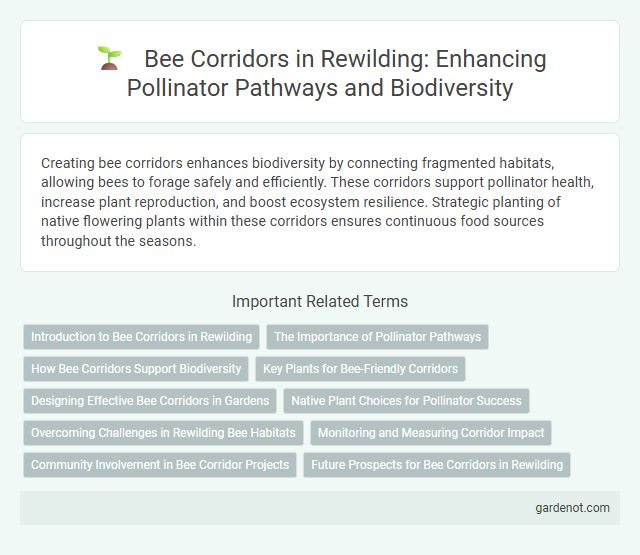Creating bee corridors enhances biodiversity by connecting fragmented habitats, allowing bees to forage safely and efficiently. These corridors support pollinator health, increase plant reproduction, and boost ecosystem resilience. Strategic planting of native flowering plants within these corridors ensures continuous food sources throughout the seasons.
Introduction to Bee Corridors in Rewilding
Bee corridors play a crucial role in rewilding by providing continuous habitats that support pollinator health and biodiversity. These corridors connect fragmented landscapes, enabling bees to forage efficiently and maintain genetic diversity essential for ecosystem resilience. Establishing bee corridors enhances pollination services, promoting the regeneration of native plants and contributing to sustainable ecosystem restoration.
The Importance of Pollinator Pathways
Bee corridors serve as essential pollinator pathways that facilitate the movement and foraging of bees across fragmented habitats, boosting biodiversity and ecosystem resilience. These green routes increase the availability of native flowering plants, ensuring continuous nectar and pollen resources vital for bee health and reproduction. Establishing and maintaining bee corridors supports crop pollination, enhances food security, and mitigates declines in pollinator populations caused by habitat loss and urbanization.
How Bee Corridors Support Biodiversity
Bee corridors enhance biodiversity by connecting fragmented habitats, allowing bees to forage efficiently and pollinate a diverse range of plants. These corridors increase genetic diversity within bee populations and support the reproduction of native flora, which benefits entire ecosystems. By promoting healthy pollinator networks, bee corridors contribute to the resilience and stability of local biodiversity.
Key Plants for Bee-Friendly Corridors
Bee corridors thrive with key plants like lavender, clover, and wildflowers such as foxglove and poppy, which provide abundant nectar and pollen sources for native bee species. Incorporating a diverse mix of native flowering plants ensures seasonal blooms that support bee populations throughout their active periods. Planting hedgerows and flowering strips with species such as willow, borage, and heather enhances habitat connectivity, promoting pollinator movement across fragmented landscapes.
Designing Effective Bee Corridors in Gardens
Designing effective bee corridors in gardens involves planting diverse native flowering plants that provide continuous bloom throughout the seasons to support pollinator activity. Incorporating layered vegetation structures, including ground cover, shrubs, and trees, creates varied habitats and shelter for different bee species. Minimizing pesticide use and ensuring connectivity between green spaces enhance habitat quality and facilitate safe bee movement within urban environments.
Native Plant Choices for Pollinator Success
Choosing native plants like goldenrod, milkweed, and coneflower is essential for creating effective bee corridors that support pollinator success. These plants provide vital nectar and pollen resources that align with the nutritional needs of local bee species, enhancing biodiversity and ecosystem resilience. Incorporating native flora ensures habitat continuity and boosts wild bee populations through improved foraging and reproduction opportunities.
Overcoming Challenges in Rewilding Bee Habitats
Bee corridors play a crucial role in rewilding efforts by connecting fragmented habitats and supporting pollinator populations vital for ecosystem health. Overcoming challenges such as pesticide exposure, habitat fragmentation, and lack of floral diversity requires strategic planting of native flowering plants and the creation of safe nesting sites along these corridors. Enhancing connectivity and reducing environmental stressors promote resilience and biodiversity within bee populations, essential for successful rewilding initiatives.
Monitoring and Measuring Corridor Impact
Monitoring the bee corridor involves tracking pollinator diversity, abundance, and foraging behavior to assess habitat connectivity and health. Measuring corridor impact requires analyzing floral resource availability, nesting site utilization, and changes in pollination success rates within adjacent agricultural and natural landscapes. Data gathered through remote sensing and field surveys inform adaptive management strategies to enhance corridor effectiveness for native bee populations.
Community Involvement in Bee Corridor Projects
Community involvement plays a crucial role in the success of bee corridor projects, as local residents contribute to planting native flowering plants that support pollinator habitats. Volunteer engagement and educational workshops foster awareness about the importance of bees for biodiversity and crop pollination, encouraging sustained maintenance of these green corridors. Partnerships between schools, environmental organizations, and municipalities enhance monitoring efforts, ensuring habitats thrive and pollinator populations recover.
Future Prospects for Bee Corridors in Rewilding
Bee corridors are poised to become vital ecological infrastructures in rewilding efforts, enhancing pollinator connectivity and biodiversity across fragmented landscapes. Innovative designs integrating native flowering plants support sustainable habitats and improve pollination services essential for ecosystem resilience and agricultural productivity. Future prospects include scaling bee corridors globally, leveraging ecological monitoring technologies, and fostering community-led conservation initiatives to ensure long-term pollinator health and ecological restoration.
Bee corridor Infographic

 gardenot.com
gardenot.com